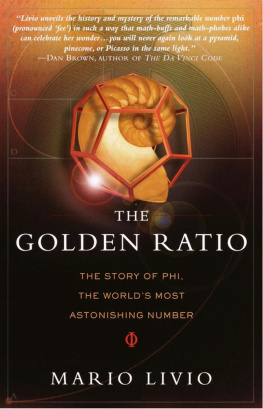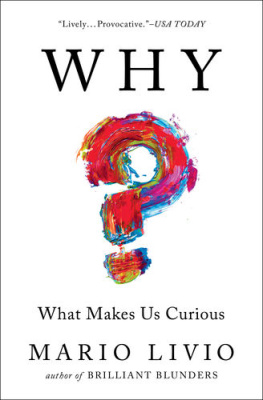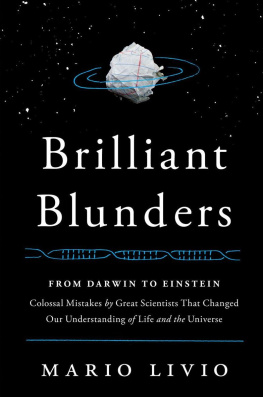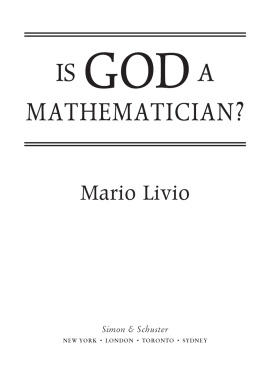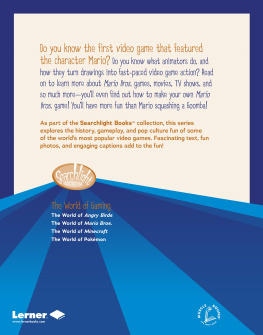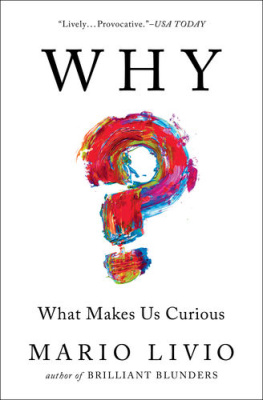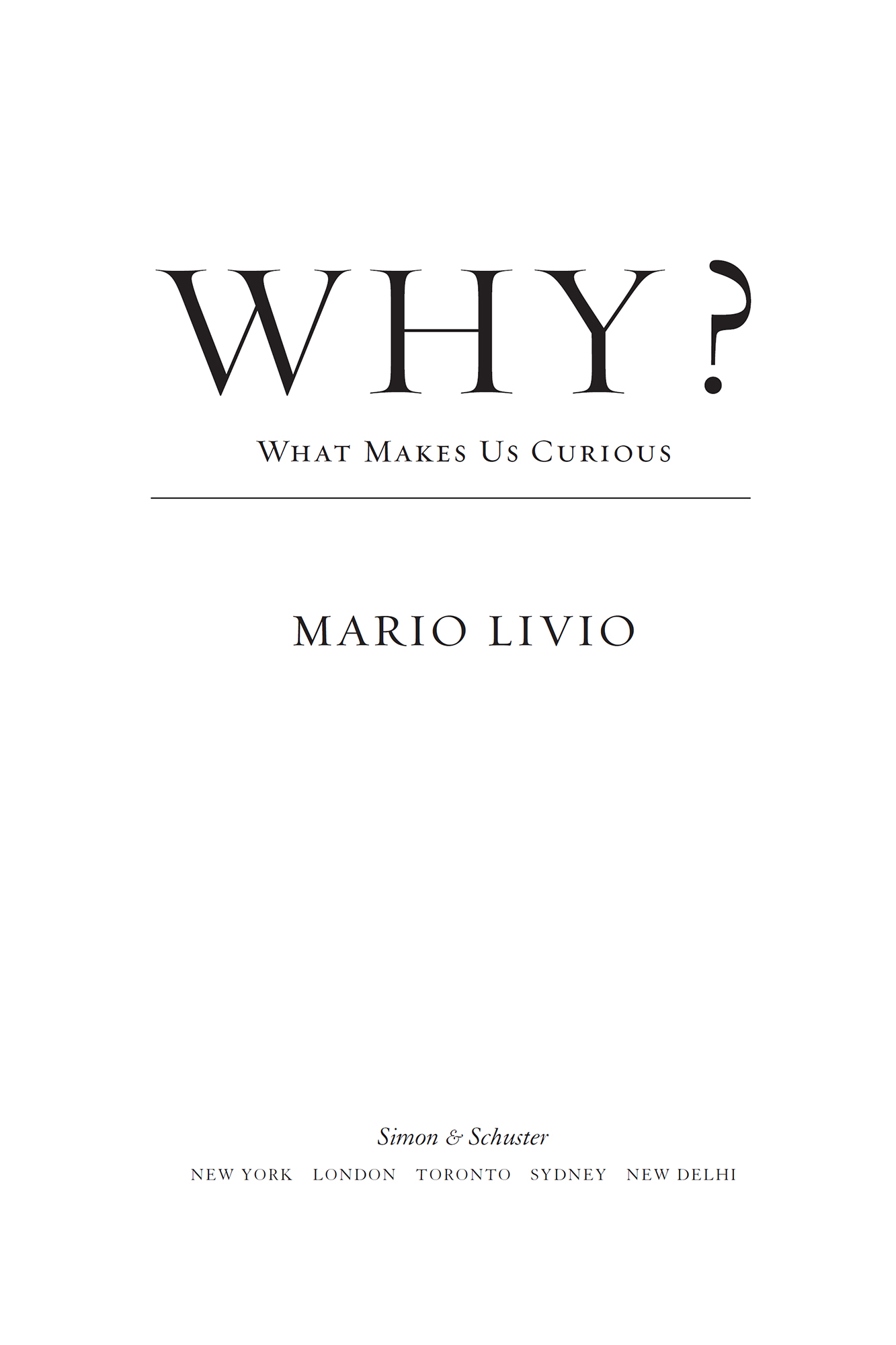We hope you enjoyed reading this Simon & Schuster ebook.
Get a FREE ebook when you join our mailing list. Plus, get updates on new releases, deals, recommended reads, and more from Simon & Schuster. Click below to sign up and see terms and conditions.
CLICK HERE TO SIGN UP
Already a subscriber? Provide your email again so we can register this ebook and send you more of what you like to read. You will continue to receive exclusive offers in your inbox.
Thank you for downloading this Simon & Schuster ebook.
Get a FREE ebook when you join our mailing list. Plus, get updates on new releases, deals, recommended reads, and more from Simon & Schuster. Click below to sign up and see terms and conditions.
CLICK HERE TO SIGN UP
Already a subscriber? Provide your email again so we can register this ebook and send you more of what you like to read. You will continue to receive exclusive offers in your inbox.
ALSO BY MARIO LIVIO
Brilliant Blunders: From Darwin to EinsteinColossal Mistakes by Great Scientists That Changed Our Understanding of Life and the Universe
Is God a Mathematician?
The Equation That Couldnt Be Solved: How Mathematical Genius Discovered the Language of Symmetry
The Golden Ratio: The Story of Phi, the Worlds Most Astonishing Number
The Accelerating Universe: Infinite Expansion, the Cosmological Constant, and the Beauty of the Cosmos

Simon & Schuster
1230 Avenue of the Americas
New York, NY 10020
www.SimonandSchuster.com
Copyright 2017 by Mario Livio
All rights reserved, including the right to reproduce this book or portions thereof in any form whatsoever. For information, address Simon & Schuster Subsidiary Rights Department, 1230 Avenue of the Americas, New York, NY 10020.
First Simon & Schuster hardcover edition July 2017
SIMON & SCHUSTER and colophon are registered trademarks of Simon & Schuster, Inc.
For information about special discounts for bulk purchases, please contact Simon & Schuster Special Sales at 1-866-506-1949 or .
The Simon & Schuster Speakers Bureau can bring authors to your live event. For more information or to book an event, contact the Simon & Schuster Speakers Bureau at 1-866-248-3049 or visit our website at www.simonspeakers.com.
Interior design by Paul Dippolito
Jacket Illustration by Jason Heuer
Library of Congress Cataloging-in-Publication Data
Names: Livio, Mario, 1945 author.
Title: Why? : what makes us curious / by Mario Livio.
Description: New York : Simon & Schuster, 2017. | Includes bibliographical references and index.
Identifiers: LCCN 2016040604| ISBN 9781476792095 | ISBN 1476792097
Subjects: LCSH: CuriosityHistory.
Classification: LCC BF323.C8 L58 2017 | DDC 153.3dc23 LC record available at https://lccn.loc.gov/2016040604
ISBN 978-1-4767-9209-5
ISBN 978-1-4767-9212-5 (ebook)
To my mother
Contents
Preface
I HAVE ALWAYS BEEN A very curious person. In addition to my professional interests as an astrophysicist in deciphering the cosmos and various phenomena within it, I have maintained a passion for the visual arts. I have absolutely no artistic talent, but I have amassed a large collection of art books. I am also a science advisor to the Baltimore Symphony Orchestra (yes, there is such a thing), and I have participated in a few of its concerts as a presenter of the links between science and music. Perhaps most exciting from my perspective has been my participation in the creation of the Hubble Cantata, a contemporary classical music piece by composer Paola Prestini, accompanied by film and virtual reality, all inspired by images taken with the Hubble Space Telescope. In addition, in a regular blog posted on the Huffington Post , I tend to informally muse about topics in science and art and the intricate connections between them.
Not surprisingly, therefore, already a long time ago I became intrigued by the questions What is it that triggers curiosity? and What are the underlying mechanisms of curiosity and exploration? Since this was not my area of expertise, I had to engage in an enormous amount of research, consult with numerous psychologists and neuroscientists, discuss the topic with many scholars from a variety of disciplines, and interview a large number of people whom I believed to be exceptionally curious. As a result, I am deeply indebted to scores of individuals without whom I could not have completed this project. While it would be impractical to attempt to thank them all here, I would like to at least acknowledge a group of people who have both profoundly inspired and greatly informed my writing. I am indebted to Paolo Galluzzi for an illuminating conversation on Leonardo da Vinci and to Jonathan Pevsner for helpful advice on Leonardo and for allowing me to use his vast collection of books and articles on Leonardo. Agata Rutkowska has been a wonderful guide for finding specific Leonardo drawings in the Royal Collection Trust. The Milton S. Eisenhower Library at Johns Hopkins University provided me with hundreds of books on a wide range of relevant disciplines. Jeremy Nathans, Doron Lurie, Garik Israelian, and Ellen-Thrse Lamm introduced me to people who gave crucial interviews. I am grateful to Joan Feynman, David and Judith Goodstein, and Virginia Trimble for valuable, firsthand information about Richard Feynman.
Jacqueline Gottlieb, Laura Schulz, Elizabeth Bonawitz, Marieke Jepma, Jordan Litman, Paul Silvia, Celeste Kidd, Adrien Baranes, and Elizabeth Spelke provided me with invaluable information, sometimes even before publication, about their research projects in a variety of areas of psychology and neuroscience, all aimed at a better understanding of the nature of curiosity. Any mistakes the book might contain about the interpretation of their results are mine alone. Jonna Kuntsi and Michael Milham clarified for me concepts and potential connections between curiosity and ADHD . Kathryn Asbury discussed with me the implications of various studies involving twins for the nature of curiosity. Suzana Herculano-Houzel explained to me in detail her groundbreaking studies of the constituents of the brain in general and their significance and ramifications for the unique properties of the human brain in particular. Noam Saadon-Grossman helped me navigate the anatomy of the brain. I wish to express my gratitude to Freeman Dyson, Story Musgrave, Noam Chomsky, Marilyn vos Savant, Vik Muniz, Martin Rees, Brian May, Fabiola Gianotti, and Jack Horner for giving me fabulously interesting and insightful interviews about their own personal curiosity.
Finally, I thank my wonderful agent, Susan Rabiner, for her tireless encouragement and advice. I am grateful to my editor, Bob Bender, for his careful reading of the manuscript and his perceptive and thoughtful comments. General manager Johanna Li, designer Paul Dippolito, copy editor Phil Metcalf, and the entire team at Simon & Schuster again demonstrated their dedication and professionalism in producing this book.
Needless to say, without the patience and continuous support of my wife, Sofie, this book would never have seen the light of day.
ONE
Curious
INDEPENDENT OF THEIR LENGTH, SOME stories can leave lasting impressions. The Story of an Hour, a very short tale by the nineteenth-century author Kate Chopin, opens with a rather startling sentence: Knowing that Mrs. Mallard was afflicted with a heart trouble, great care was taken to break to her as gently as possible the news of her husbands death. Loss of life and human frailty all packed into one punchy line. We then learn that it was the husbands close friend, Richards, who brought the bad news, after having confirmed (by way of a telegram) that Brently Mallards name was indeed leading the list of those killed in a railroad disaster.
Next page

